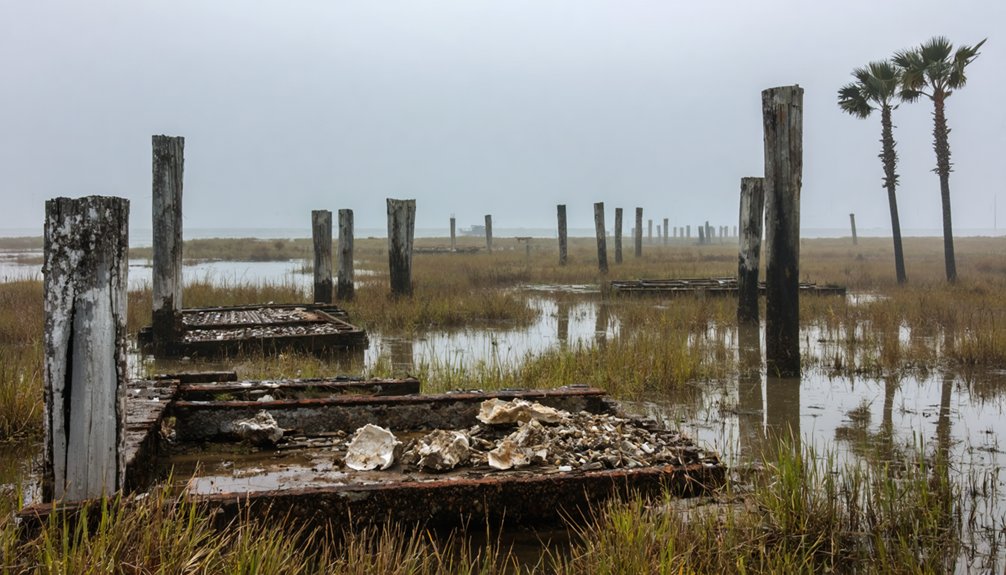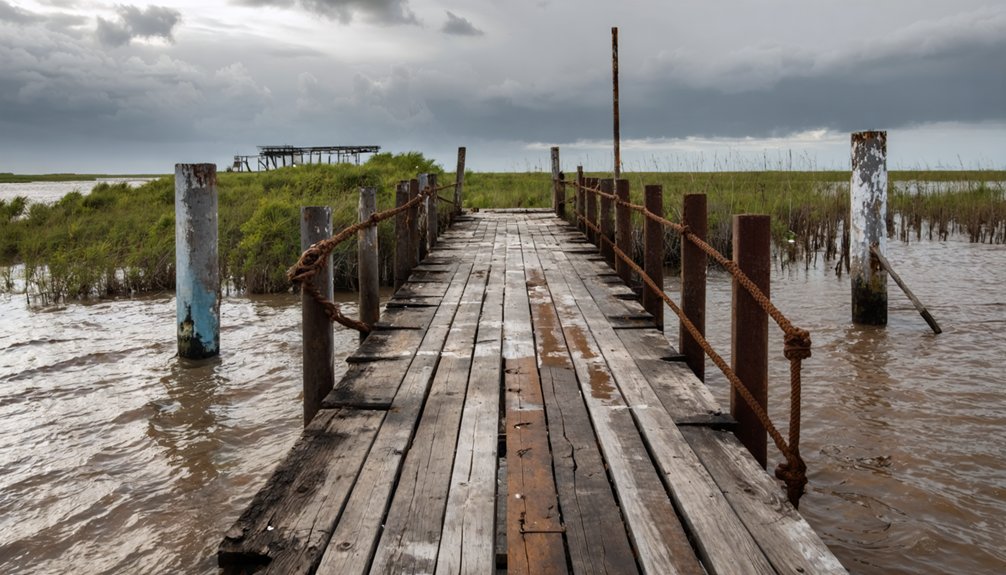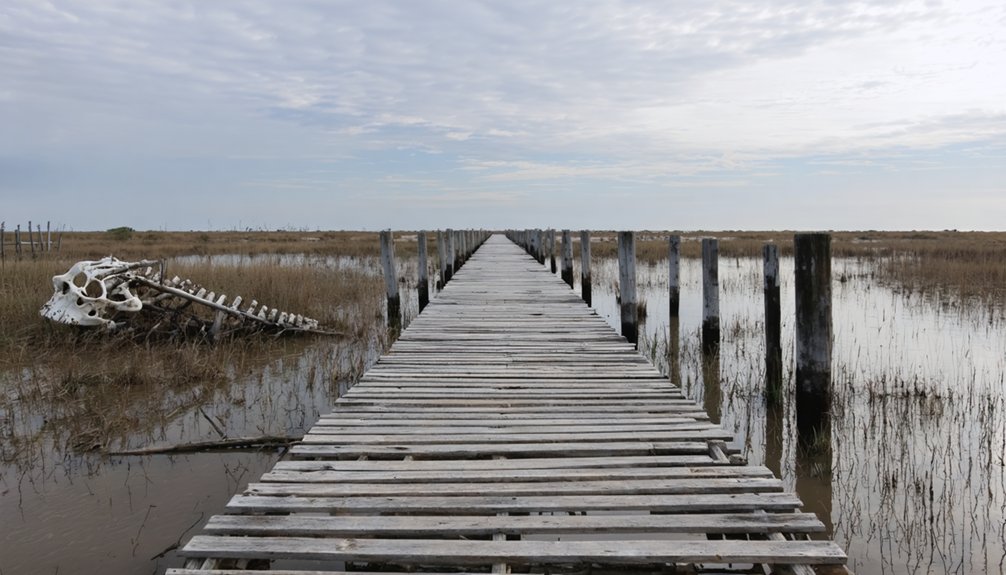You’ll find St. Mary’s of Aransas, Texas as a ghost town that once thrived as a major Gulf Coast port in the 1850s-1880s. Founded in 1857, it flourished through maritime trade and cattle shipping until the Civil War brought devastating Union raids in 1862. Successive hurricanes in the 1880s, combined with the arrival of railways favoring nearby Rockport, sealed its fate. Today, only the historic Wood Mansion, cemetery, and scattered shellcrete ruins tell its compelling story.
Key Takeaways
- Founded in 1857 as a major port town, St. Mary’s of Aransas thrived through maritime trade and cattle shipping until the early 1900s.
- Union forces destroyed vital infrastructure during the Civil War, initiating the town’s gradual decline.
- Devastating hurricanes in 1886 and 1887 destroyed wharves and warehouses, severely impacting maritime commerce.
- The arrival of the St. Louis Railway in 1905 redirected shipping routes, leading to the town’s abandonment by 1907.
- Today, only the Wood Mansion, cemetery, and scattered shellcrete ruins remain as testament to the former prosperous port town.
The Rise of a Thriving Texas Port Town
When Joseph F. Smith founded St. Mary’s of Aransas in 1857, you’d have witnessed the birth of what quickly became one of western Texas’s most crucial ports.
Smith’s ambitious design featured seven tiers of 13 blocks, anchored by his three-story shellcrete home and essential port infrastructure along Copano Bay.
Smith created an orderly town plan with precise tiers and blocks, his grand shellcrete residence dominating the Copano Bay waterfront.
You’d have found a bustling town where wagon trains regularly departed for San Antonio and the Rio Grande, loaded with lumber imported from Florida. The area’s earliest inhabitants, the Karankawa Indians, had long since moved from these coastal lands.
The town’s social institutions reflected its prosperity – a two-story opera house hosted cultural engagement, while a Presbyterian church served double duty as a school.
The town became a strategic target during the Civil War, with Union forces destroying the once-thriving port settlement.
Economic Glory Days on Copano Bay
You’ll find that during its economic peak, St. Mary’s of Aransas positioned itself as one of Texas’ most crucial maritime trade centers, with its strategic location on Copano Bay facilitating extensive import-export operations through multiple deep-water wharves.
The port’s significance grew as it became the primary transportation hub for the region’s booming cattle industry, with ranchers driving their herds to the coast for processing and shipping. During this bustling period, merchants regularly received imported pottery and china through the port’s customs house. The bay’s maximum depth of 3 meters allowed smaller vessels to navigate safely to the port.
The town’s prosperity reached new heights as it emerged as the region’s leading export point for raw materials, including leather goods, tallow, and other cattle-derived products bound for distant markets.
Maritime Trade Hub Dominance
Three key factors positioned St. Mary’s of Aransas as a dominant maritime trade hub: its strategic location on Copano Bay, robust infrastructure development, and access to essential commodities.
You’ll find the port’s maritime infrastructure development centered around deep-water wharves and extensive warehouses, enabling large vessel docking and efficient cargo handling. Cargo vessels commonly transported lumber and shingles according to local shipping records. Ships frequently made voyages to international ports including Hamburg, Havana, and Liverpool.
The port’s trade route evolution established it as a significant nexus for regional commerce, connecting coastal resources with inland markets like Refugio, Goliad, and San Antonio.
During its peak, St. Mary’s handled:
- Lumber shipments from local sources and Florida via large schooners
- Agricultural exports, particularly cotton, supporting the regional economy
- Hide and tallow trade, linking coastal resources to inland markets
This maritime dominance continued until the 1875 hurricane damaged critical infrastructure, marking the beginning of the port’s decline.
Cattle Industry Transportation Center
St. Mary’s emerged as an essential cattle transportation hub during the late 19th century, serving as a critical gateway for Texas ranchers seeking access to distant markets.
You’ll find that its strategic location on Copano Bay made it the perfect maritime launching point for cattle shipments before railroads dominated the region.
The town’s economic dependence on the cattle industry brought prosperity throughout the 1870s and 1880s.
Following the St. Louis Railway arrival in 1905, the region’s shipping patterns shifted dramatically away from coastal ports.
You can trace this success to the extensive network of wharves and docks that facilitated livestock transport, while local packing houses processed beef worth hundreds of thousands of dollars annually.
The Joseph F. Smith wharf operations established in 1867 further solidified the area’s prominence in maritime trade.
However, the town’s fortune changed dramatically when devastating storms destroyed its essential port infrastructure in the mid-1880s.
This damage, combined with Rockport’s new railroad connection in 1888, effectively ended St. Mary’s reign as a cattle shipping powerhouse.
Regional Materials Export Capital
Before becoming a cattle shipping hub, the bustling port town flourished as western Texas’s premier lumber and building materials center.
You’d find wagon trains regularly departing from St. Mary’s of Aransas, loaded with timber and construction supplies bound for inland settlements. The port’s export strategies centered on maximizing the region’s natural resources, particularly the dense coastal forests. The area would later experience a similar economic boom when crude oil exports surged after federal restrictions were lifted in 2015.
The town’s labor dynamics relied heavily on manual workers for:
- Harvesting raw materials from nearby forests
- Loading goods onto coastal vessels in Copano Bay
- Operating wagon trains to interior markets like Goliad and San Antonio
Despite shallow waters limiting large ship access, you could witness a thriving trade network that made St. Mary’s the primary export capital in western Texas during the early settlement era, with customs duties collected through the Mexican port of El Cópano. Similar to how the Karankawas by 1500s had recognized the economic potential of the coastal region, early settlers capitalized on the area’s natural resources for trade.
Civil War’s Devastating Impact
As the American Civil War intensified in late 1861, the Union Navy established a coastal blockade targeting the essential Confederate supply routes through Aransas Bay and surrounding waters.
You’ll find that this military strategy effectively strangled the region’s critical trade of cotton, beef, and salt.
The war’s impact was particularly devastating to St. Mary’s infrastructure. In February 1862, Union Marines aboard USS Afton raided San Jose Island, burning the town of Aransas and destroying warehouses, piers, and docks.
The civilian exodus followed as residents fled to avoid the conflict. By Christmas 1862, Confederate forces had partially destroyed the Aransas Bay lighthouse, removing 20-25 feet of brickwork.
The combination of infrastructure destruction and population displacement effectively ended St. Mary’s prominence as a regional port.
Natural Forces Reshape History

Natural forces dealt devastating blows to St. Mary’s of Aransas in the 1880s, forever altering its destiny.
You’ll find that back-to-back hurricanes in 1886 and 1887 wreaked havoc on this coastal town, destroying crucial infrastructure and nearly obliterating the entire community.
The town’s strategic location on Copano Bay, while perfect for shipping, proved to be its undoing.
Consider these significant impacts of natural disasters:
- Destruction of wharves and warehouses crippled maritime commerce
- Railway lines bypassed the storm-damaged town for nearby Rockport
- Population exodus led to closure of fundamental services by 1907
Despite this brutal environmental reshaping, St. Mary’s historical resilience lives on through surviving structures like the Wood Mansion and Clara Driscoll monument, telling a compelling story of nature’s power to transform communities.
The Final Years of a Once-Bustling Community
You’ll find that St. Mary’s final years were marked by the dwindling operations of a few remaining businesses struggling against mounting economic pressures.
The absence of rail connections and the deterioration of port facilities left the town with minimal commercial activity, as merchants gradually relocated to more prosperous neighboring communities.
Natural elements began reclaiming the landscape as buildings fell into disrepair and the once-busy streets grew quiet, marking the shift of St. Mary’s from a vibrant port town to a ghost town.
Last Economic Activities Standing
The final economic activities of St. Mary’s centered around a handful of fading businesses that persisted despite the town’s decline.
You’d have found these community remnants struggling to maintain operations as the once-bustling port town faced its inevitable downfall.
The last surviving enterprises before the town’s absorption into Bayside included:
- The general store, which operated until 1907
- The Wood Mansion, built in 1875, serving as a symbol of the town’s former prosperity
- A post office that managed to stay open until 1907
While shipping had long ceased due to the wreckage in Copano Bay, and the railway’s decision to bypass St. Mary’s sealed its commercial fate, these final establishments represented the last gasps of a once-thriving economic center.
Natural Forces Take Over
While the remaining businesses fought to stay alive, Mother Nature dealt the final blows to St. Mary’s in the late 1880s.
You’d have witnessed the town’s lack of storm resilience when a devastating hurricane in 1886 destroyed essential structures, including the wharves and schoolhouse. Just a year later, an even more powerful storm nearly wiped the settlement off the map.
The coastal erosion and repeated storm damage left the port facilities in ruins, making any chance of economic recovery almost impossible.
With no railway connection to aid rebuilding efforts, you would’ve seen the population scatter to nearby towns like Bayside, which offered better shelter from the Gulf’s fury.
Hidden Historical Treasures

Beneath the quiet landscape of modern-day Bayside lie fascinating remnants of St. Mary’s of Aransas, where hidden artifacts and forgotten legends tell tales of a once-bustling port town.
You’ll discover traces of the town’s glory days through several preserved historical treasures that have withstood time and nature.
The most significant historical sites you can explore today include:
- The historic Wood Mansion, built in 1875, offering a glimpse into 19th-century coastal Texas life
- St. Mary’s cemetery, preserving the memory of early settlers and prominent citizens
- A monument marking Clara Driscoll’s family home, commemorating the “Savior of the Alamo”
These surviving structures stand as silent witnesses to St. Mary’s rich history, from its days as South Texas’s educational pioneer to its role as an essential shipping port.
Legacy in Texas Maritime History
Beyond the physical remnants of St. Mary’s lies a rich legacy of maritime innovation and strategic importance in Texas history.
You’ll find its influence deeply woven into the region’s development, from its essential role as a supply port for the U.S. Army to its later significance during the Civil War.
As you explore St. Mary’s history, you’ll discover how this bustling port transformed Texas commerce through its extensive maritime infrastructure and diverse trading operations.
The port’s strategic location made it critical for Confederate blockade running, while its skilled bar pilots navigated treacherous waters, enabling safe passage for countless vessels.
St. Mary’s port location proved invaluable during the Civil War, as expert pilots guided blockade runners through dangerous coastal waters.
Through its dynamic shipping activities and industrial ventures, St. Mary’s helped build western Texas economies, connecting inland communities to important maritime trade routes until its decline in 1875.
Preservation Challenges and Future Outlook

Despite enduring nearly 150 years of coastal weather, the remaining structures of St. Mary’s face significant preservation challenges.
You’ll find only scattered shellcrete ruins, the historic cemetery, and the Wood Mansion still standing as evidence of this once-thriving port town.
Two devastating hurricanes in the 1880s accelerated the site’s decline, and ongoing coastal threats continue to endanger these fragments of history.
Current preservation strategies focus on:
- Archaeological surveys to document subsurface artifacts and foundations
- Community engagement through local historical societies and guided tours
- Integration with Bayside’s heritage tourism initiatives
You’ll see how limited funding and natural disaster risks have complicated preservation efforts, though the town’s incorporation into Bayside offers new opportunities.
The Aransas County Historical Society continues leading initiatives to protect what remains of this important maritime settlement.
Frequently Asked Questions
What Was the Average Property Value in St. Mary’s During Its Peak?
You won’t find exact historical valuations, but property trends suggest peak values occurred between 1850-1869 when the bustling port town served as a commercial hub and county seat.
How Many Ships Typically Docked at St. Mary’s Port Each Month?
You’ll find shipping frequency records indicate between 20-50 vessels docked monthly during peak port activity, with the exact count varying by season, weather conditions, and regional trade demands.
What Were the Major Immigrant Groups That Settled in St. Mary’s?
You’ll find that Irish immigrants formed the earliest European settlement wave, followed by Anglo-Americans and some German settlers. Mexican families were already present in the area before colonization began.
Did Any Famous Outlaws or Gunfighters Ever Visit St. Mary’s?
You won’t find any confirmed outlaw sightings or gunfighter legends here. Historical records show St. Mary’s was strictly a bustling commercial port, focusing on shipping rather than harboring any notorious characters.
What Native American Tribes Inhabited the Area Before St. Mary’s Establishment?
You’ll find that Karankawas and Coahuiltecans dominated this coastal region, with cultural significance tied to tribal legends of hunting and fishing. The Aransas Indians lived here earlier, leaving around 1300.
References
- https://www.rockportfulton.com/history-of-aransas-county
- https://texashighways.com/travel-news/four-texas-ghost-towns/
- https://portaransasmuseum.org/pam-wheat-stranahan-ghost-towns-of-copano-bay/
- https://www.theachistorycenter.com/history-mystery-1/what-civil-war-invasions-occurred-in-copano-bay?
- http://www.stxmaps.com/go/st-marys-ghost-town.html
- https://www.expressnews.com/news/houston-weather/article/texas-ghost-towns-extreme-weather-hurricanes-19874031.php
- https://www.portasouthjetty.com/articles/ghost-towns/
- https://www.tshaonline.org/handbook/entries/st-marys-of-aransas-tx
- https://www.rockport-fulton-historichometour.org/aransas-history-articles/history-mysteries-2015-2016/what-happened-to-st-mary-s
- https://www.tshaonline.org/handbook/entries/aransas-county



